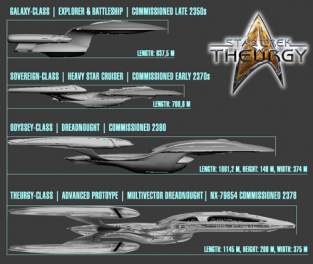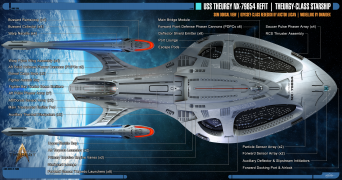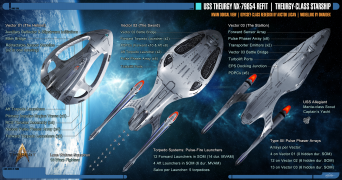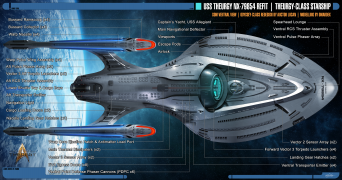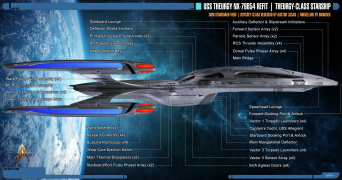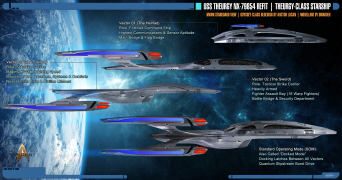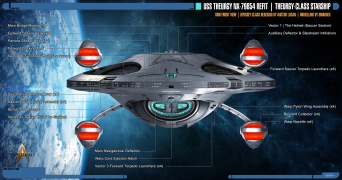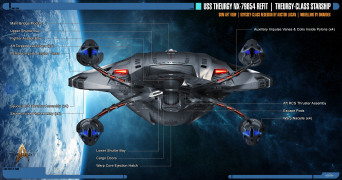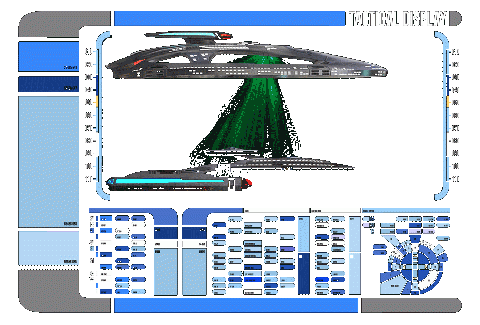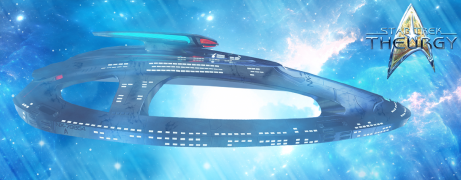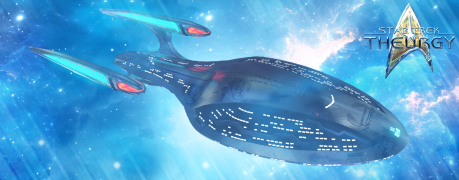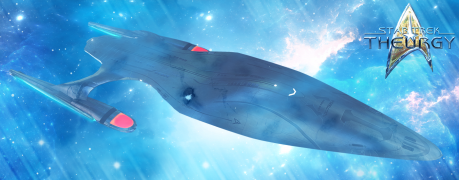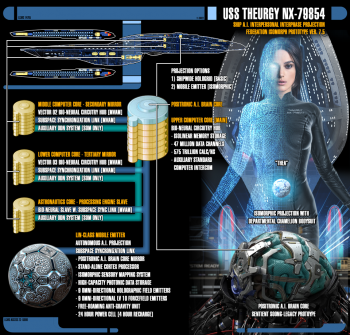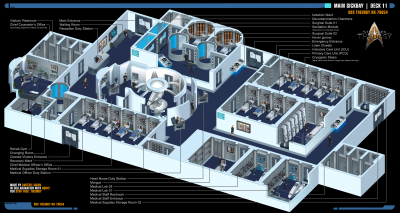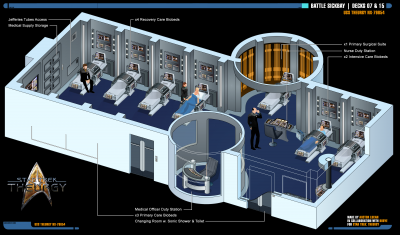Star trek theurgy что это
USS Theurgy
From Star Trek: Theurgy Wiki
Contents
Starship Demonstration
History
Construction and Launch
The Theurgy was built in a joint venture between the Antares Shipyards and Utopia Planitia Fleet Yards before being commissioned on October 9th, 2378. The USS Theurgy was one of the most advanced Starfleet vessels ever constructed and was meant to be the pinnacle of starship design, destined to carry the Federation into a new generation of exploration in the next century.
Officially, both the Odyssey and the Theurgy-classes were rushed into production because of the Romulan Civil War. Unofficially, there are those who believe Starfleet Command pushed the production ahead of schedule for sake of their own agenda. The list of commissioned starships of the Theurgy-class in pre-production are the following:
Commissioned Theurgy-class Starships (January 2381):
Hijacking
According to official Starfleet records, in early November 2380, after returning to base in San Francisco after a long diplomatic mission to Romulus, the senior staff of the USS Theurgy was involved in an attempt to overthrow Starfleet Command. Forced to leave Earth, Captain Jien Ives hijacked the Theurgy and defected, alongside his entire crew, to the Romulans. All attempts by Starfleet to apprehend the ship and its crew have thus far been unsuccessful. The whereabouts of the USS Theurgy are unknown at this time.
Physical Arrangement
The Theurgy-class shared similar design characteristics with the smaller Odyssey and Prometheus class starships. The design included three hull sections, each of which could be reversibly separated: an arrowhead-shaped primary hull, a detachable secondary hull equipped with a fighter bay, and a deployable tertiary hull housing the primary warp engines. All three sections were equipped with independent warp-capable flight and combat capabilities in the multi-vector assault mode (MVAM). While other starship classes had similar capabilities, such as the Galaxy-class with its saucer separation feature, generally the saucer section of such classes had no warp drive and limited weaponry.
MVAM – Multi Vector Assault Mode
Vector 01 «The Helmet»
The docking procedure would extend Vector 01’s shields around the ship it docks with as well, and inside the ventral ring of the Vector, docking pylons would extend out to the ship’s airlocks. The ventral tractor beam would adjust positioning to ensure that as many airlocks as possible could be opened. The nacelle on top of the saucer (which was actually two sets of warp coils in one nacelle frame) could remain extended if so required to augment the warp field of the lower ship. In short, even if Vector 02 would be destroyed in battle, the fortified command ship of Vector 01 could still retreat at a much higher warp speed than the saucer alone could generate.
Vector 02 «The Sword»
This vector had the Fighter Assault Bay and all the warp fighters as well as the pod launching platforms, giving it the nickname «the sword» since it was the Vector with the most «teeth». In short, it’s role was to be a tactical strike carrier during battle.
Vector 03 «The Stallion»
This is the stardrive section of the ship, which was the fastest one and it also housed the majority of all the crew quarters. While holding more than adequate tactical systems, it was primarily the fastest the three Vectors. With the most mass and interior space, this could also be considered the lifeboat of the three Vectors.
Vector 01+02 «The Soldier»
Vector 02+03 «The Ranger»
This combination of the second and third sections of the Theurgy is called the Ranger, since it lacks the Helmet and yet has the best propulsion and fighting capabilities of the Theurgy.
Deck Layout
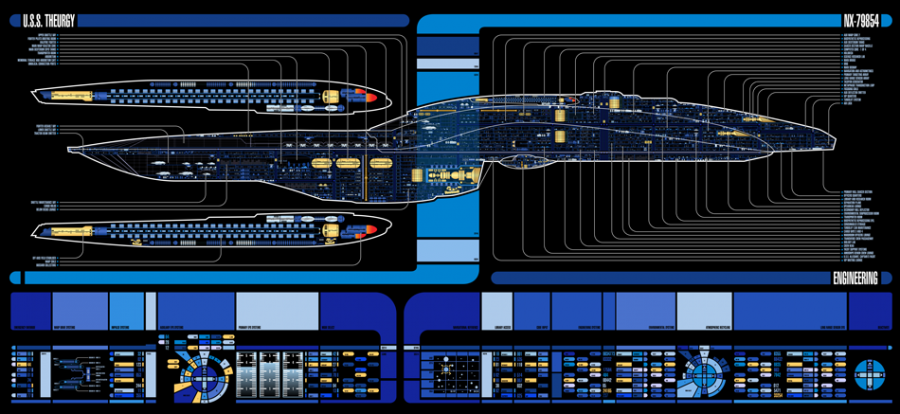
DeviantArt full resolution view: http://auctor-lucan.deviantart.com/art/U-S-S-Theurgy-MSD-by-LCARSgfx-607876043
MVAM Gallery
Images of the three Vectors in the Azure Nebula:
Command and Control Systems
Main Bridge
iframe
Diclaimer: Original 3D model by Calamity SI, with edits to the design by Auctor Lucan.
The main bridge of the Theurgy-class was circular with an extended section to the rear and served as a nerve center of the vessel.
At the rear of the Bridge was a large console and data readout screens. In the center of that area was the Master Systems Display, and this was where the support staff on the bridge worked. In front of the information center was a free standing holographic tactical display table which served as Missions Ops. The Missions Ops console was operated by either the Executive Officer, the Captain’s Yeoman, or a member of the Operations Team. It was used to co-ordinate all activities within the current mission’s parameters. It was usually where flight operations for the Theurgy’s compliment of Valkyrie fighters are organized.
Starboard of the Captain’s chair were the stations of the Chief Tactical Officer and his staff. This area was maintained mostly for internal security and combat situations. Other systems that could be commanded by tactical included long- and short-range sensor arrays, sensor probes, message buoys, and tractor beams. An identical area was found on the port side of the bridge, which seated the Chief Engineer and his staff. Though the position was far better served in Main Engineering, situations arose where the engineer’s presence was needed on the bridge. The console allowed complete control over all engineering and environmental systems.
Forward of the rear bridge operation areas were doorways to the starboard and port turbolifts. The security checkpoint beyond the aft-port exit allowed security officers to screen those entering the bridge, either directly from Deck 01 or via Turbolifts, with the ability to redirect the latter as required. It also provided a defendable area and held an armory for handheld weapons.
In the center of the Theurgy-class’ bridge was the command area. Here, seating was provided for the vessel’s Commanding Officer. In the armrests of the chair were miniaturized status displays. Using keyboard or vocal commands, the CO could use these controls to override the basic operation of the starship.
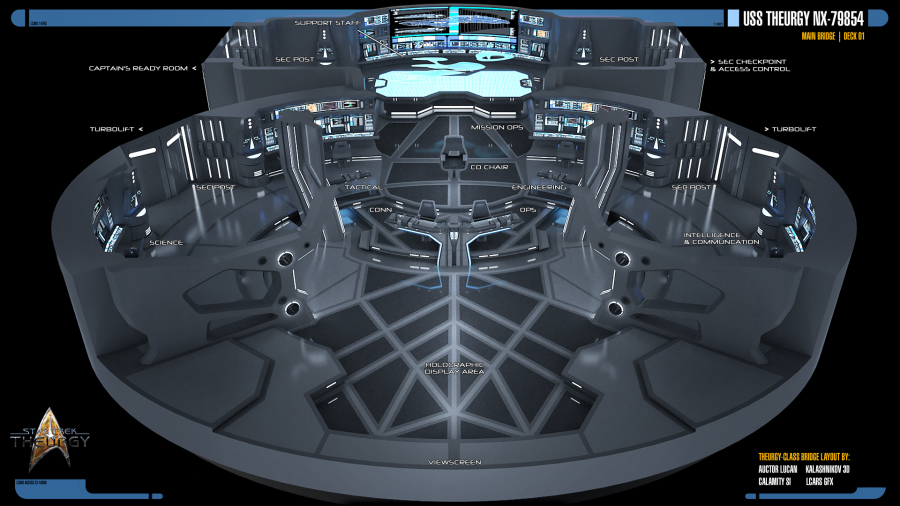
DeviantArt full resolution view: https://auctor-lucan.deviantart.com/art/USS-Theurgy-NX-79854-Main-Bridge-Cut-Away-View-677177306
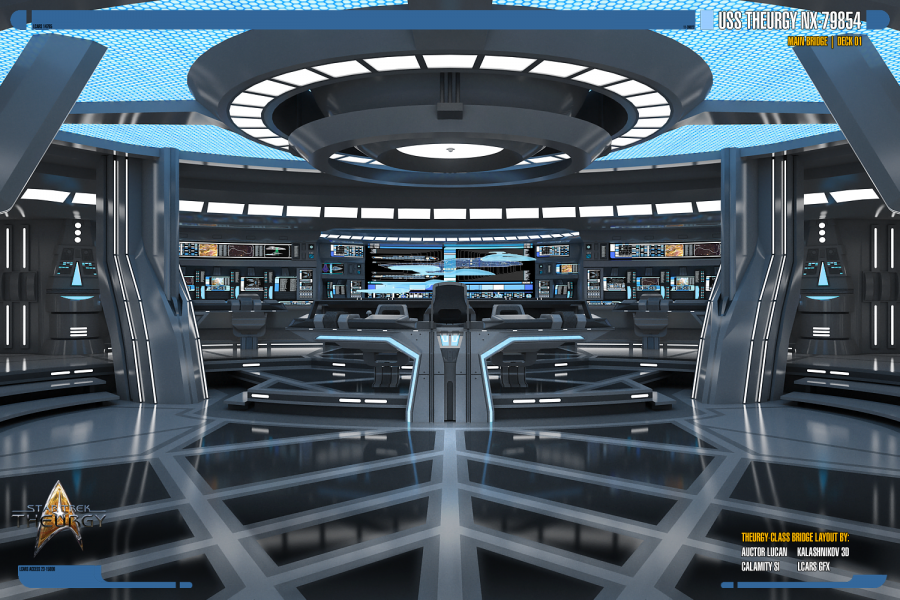
DeviantArt full resolution view: http://auctor-lucan.deviantart.com/art/USS-Theurgy-NX-79854-Main-Bridge-Render-01-680321551
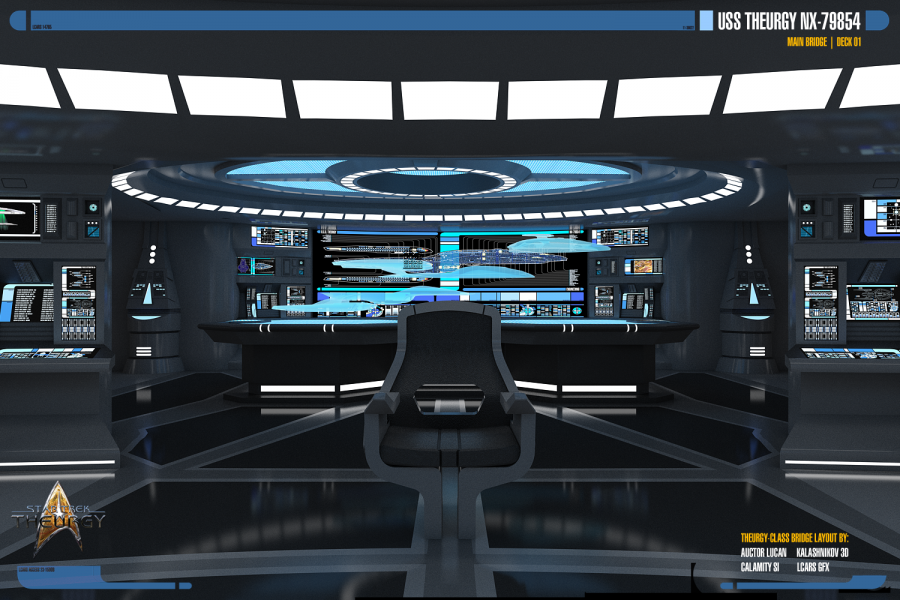
DeviantArt full resolution view: http://auctor-lucan.deviantart.com/art/USS-Theurgy-NX-79854-Main-Bridge-Render-02-680321887
Deck 01
Battle bridges
Based on Deck 8 in the Secondary Vector and Deck 11 in the Teritary Vector, the USS Theurgy has two battle bridges. These are smaller than the main bridge and are designed to operate independently as required when in Multi-Vector Assault Mode.
Computer Systems and A.I.
The computer system on board the Theurgy-class was a mixture of isolinear and bioneural based processing. Computer systems were concentrated in a computer core, which was accessible through a maintenance room. Each Theurgy-class vessel carried a total of four independent computer cores; one located in the primary vector, one in the secondary vector, and two in the tertiary vector. The top level of the Primary Computer core provided the space for the hardware of the vessel’s A.I.
Thea A.I. Overview
As time passed, the project caught the eye of non-scientists and became a political debate. While it was the Daystrom Institute’s hope that the Ship A.I. would inspire an entirely new generation of artificial intelligences capable of far more than anyone could have previously imagined, many began to concern themselves with the independent nature of living artificial intelligences installed and adapting themselves aboard torpedo-carrying starships. While the developers thought that the benefits of making a starship an essential part of its crew far outweighed the possible negative scenarios, Starfleet as a whole could not reach consensus. The solution was a set-back for the A.I. development for the sake of preserving the comfortable safety of the common standard computer integrity.
Besides the software programming, an extensive amount of hard-wiring had to be done to a starship in order to keep the software from being able to access certain key systems. Long and heated debates coursed over the matter of what an A.I. was supposed to be able to affect or not, and what manner of prerequisites were needed to alter the interface projection’s accessibility and actions. Moreover, the projection itself needed «physical» accessibility to the whole ship, and therefore required a huge amount of holo-emitters on all decks.
Subroutines would often account for the sentient qualities of A.I. and this debated Ship A.I. project was no exception. Subroutine C-47 was and still is a section of the software in each Starship’s computer responsible for non-critical systems such as replicator selections and recreational programming, all of which had to function without hampering the sentience of the interactive projection. An activation subroutine also needed to be ironed out; a standard set of procedures that were required to be followed prior to the summoning of the projection. Furthermore, a modesty subroutine was added in response to the evident fact that the hologram would not feel it was necessary to wear clothing because it would neither suffer from the elements nor leave its own «body/ship» so to speak. Suffice to say, the magnitude of the project escalated every day. The subroutines piled up, and added with the millions of other functions of the starship itself, it seemed it would become too much data to handle.
Though with the advancement in Android sciences at the Daystrom Institute, based on an advanced neural-net design of Noonien Soong and the technology of a pasitronic brain, the vague idea of a solution took form. This, however, was the point when the Dominion War broke out, and the enterprise was no more a priority.
Yet with the aforementioned return of the USS Voyager, the project received its due attention once again, and the concept of incorporating a pasitronic brain into the main computer core of a starship was given its proper chance of implementation along with the evolving Prometheus project that was about to be finalized. Moreover, the Emergency Command Hologram (ECH) was an extension of the USS Voyager’s EHM and proves essential in the development process. The program was implemented by Captain Kathryn Janeway on Voyager and would serve as a ‘backup captain’ in the event of the current command crew being incapacitated. The ECH possessed information from all major Starfleet strategic and tactical databases and could incorporate them into its plans for controlling the ship. The Ship A.I. Interface Projection possess equal command subroutines.
All the pieces of the puzzle had been uncovered, and with the blessing of Starfleet Command, results came fast. The USS Theurgy was one of the first ships to be commissioned, and it was picked for the Ship A.I. implementation.
Yet, in the end, the Daystrom Institute and hundreds of civilian programmers on the Federation’s payroll managed it all with version 7.5. Their continued efforts with the stabilized version gained great results, increasing overall efficiency, but also helping the A.I. to develop more of a personality. The result was Thea, as she began to call herself instead of Theurgy NX-79854. She was a woman who had the benefit of the complete attention of the fleet’s finest Counselors in order for her to come to terms with her existence. Throughout the years 2378 and 2379, she evolved from a simple yet highly dynamic ship’s artificial intelligence into what came to be seen as the Theurgy’s personality and guardian spirit.
Early in the year 2381, Holographic Specialist Lin Kae developed a mobile emitter for Thea, with superior sensory mapping. It gave her the ability to leave «herself» and go on away missions.
Flag Bridge
Propulsion Systems
When in standard operating mode, Theurgy-class ships achieved warp flight through four nacelles, each of which were made up of multiple pairs of warp coils. They were in turn powered by a warp core, which at the center provided energy through a matter-antimatter reaction. The assembly for such was housed in Main Engineering.
Main Engineering
Main Engineering aboard a Theurgy-class starship was located on deck 25. The room was constructed around a class 9 warp drive with a tricyclic input manifold. The core provided a maximum output of four thousand teradynes per second. The warp drive was designed to operate for up to three years before refueling. The reaction chamber was equipped with a compositor, which allowed recrystallization of dilithium. The warp drive allowed the ship a top sustainable cruise velocity of warp factor 9.995. The Theurgy-class also featured two secondary warp assemblies.
The secondary warp assemblies were housed with the primary and secondary vector, and allowed each hull of the ship to enter warp independently in MVAM. During standard operation mode, these cores idled, providing additional power to subsystems across the vessel.
The main engineering room featured three levels. In front of the warp core was a large monitoring area on the lower engineering level. Also located on this level was the chief engineer’s office and an open work area for special projects or situational analysis.
The main impulse engines on an Therugy-class starship were located on the aft primary hull. Each of the pylons leading to the warp nacelles held auxiliary impulse engines. Theurgy-class starships were also equipped with auxiliary impulse reactors.
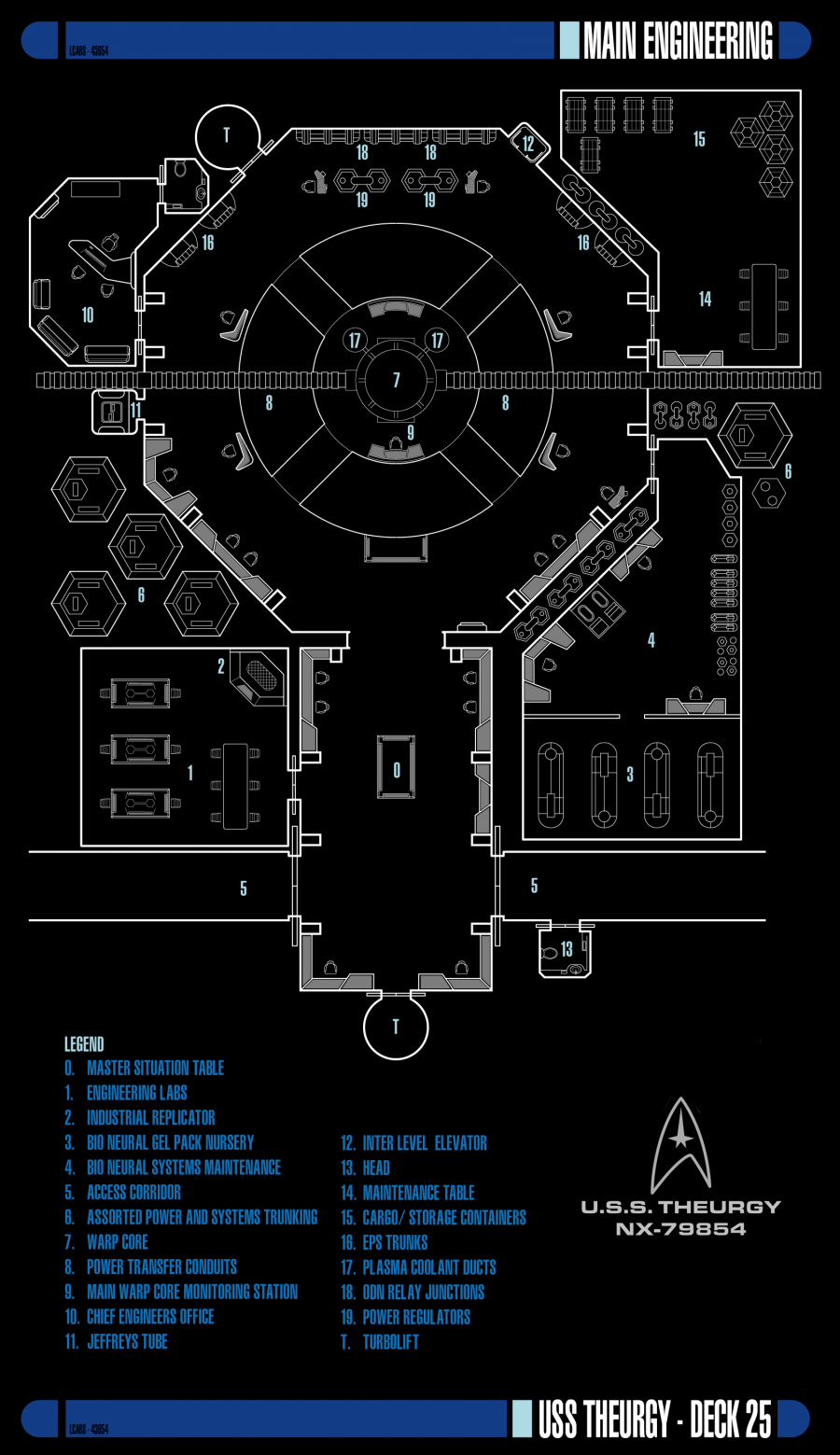
Full Resolution View at DeviantArt: http://auctor-lucan.deviantart.com/art/Main-Engineering-Deck-25-USS-Theurgy-NX-79854-680615597
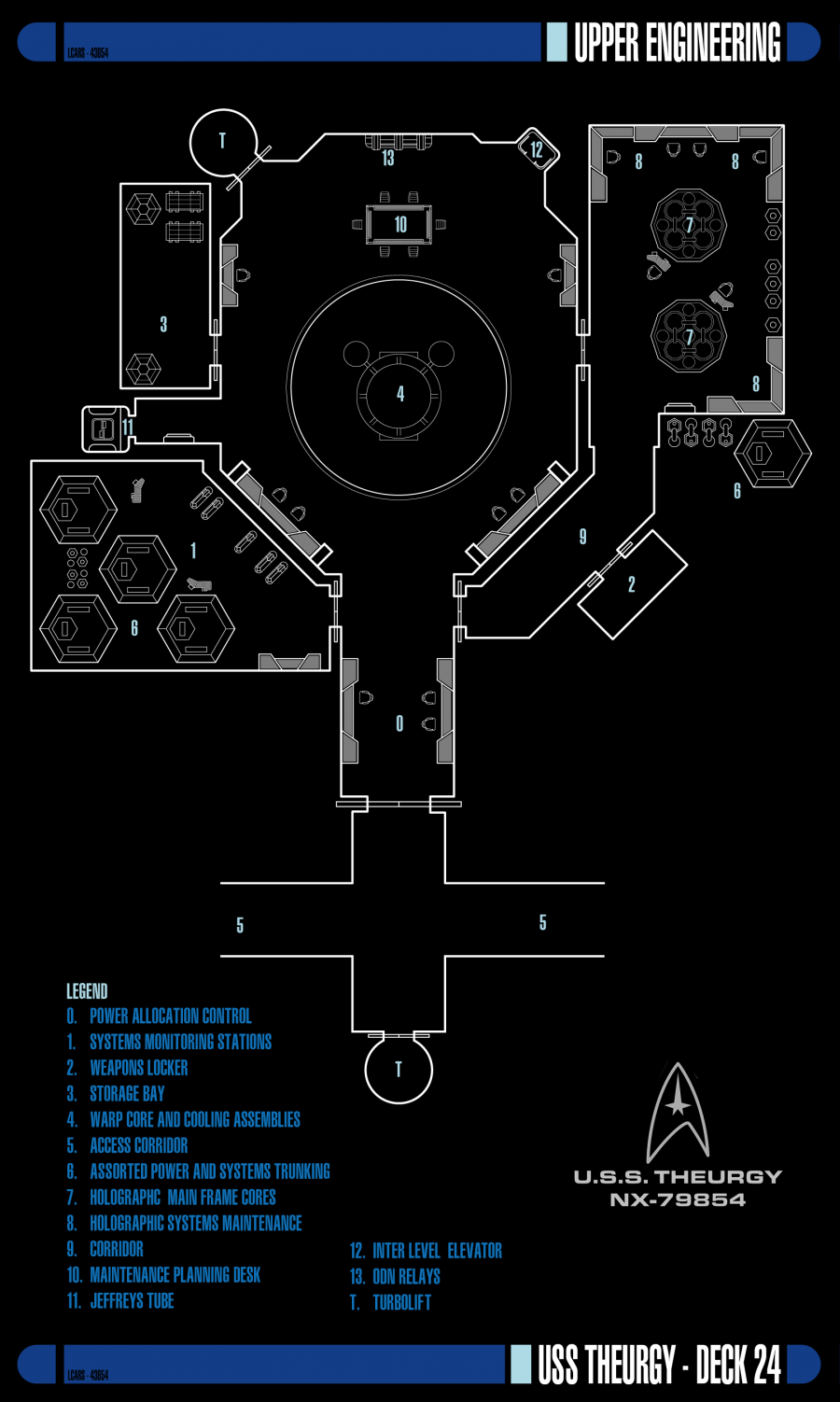
Full Resolution View at DeviantArt: http://auctor-lucan.deviantart.com/art/Upper-Engineering-Deck-24-USS-Theurgy-NX-79854-680616173
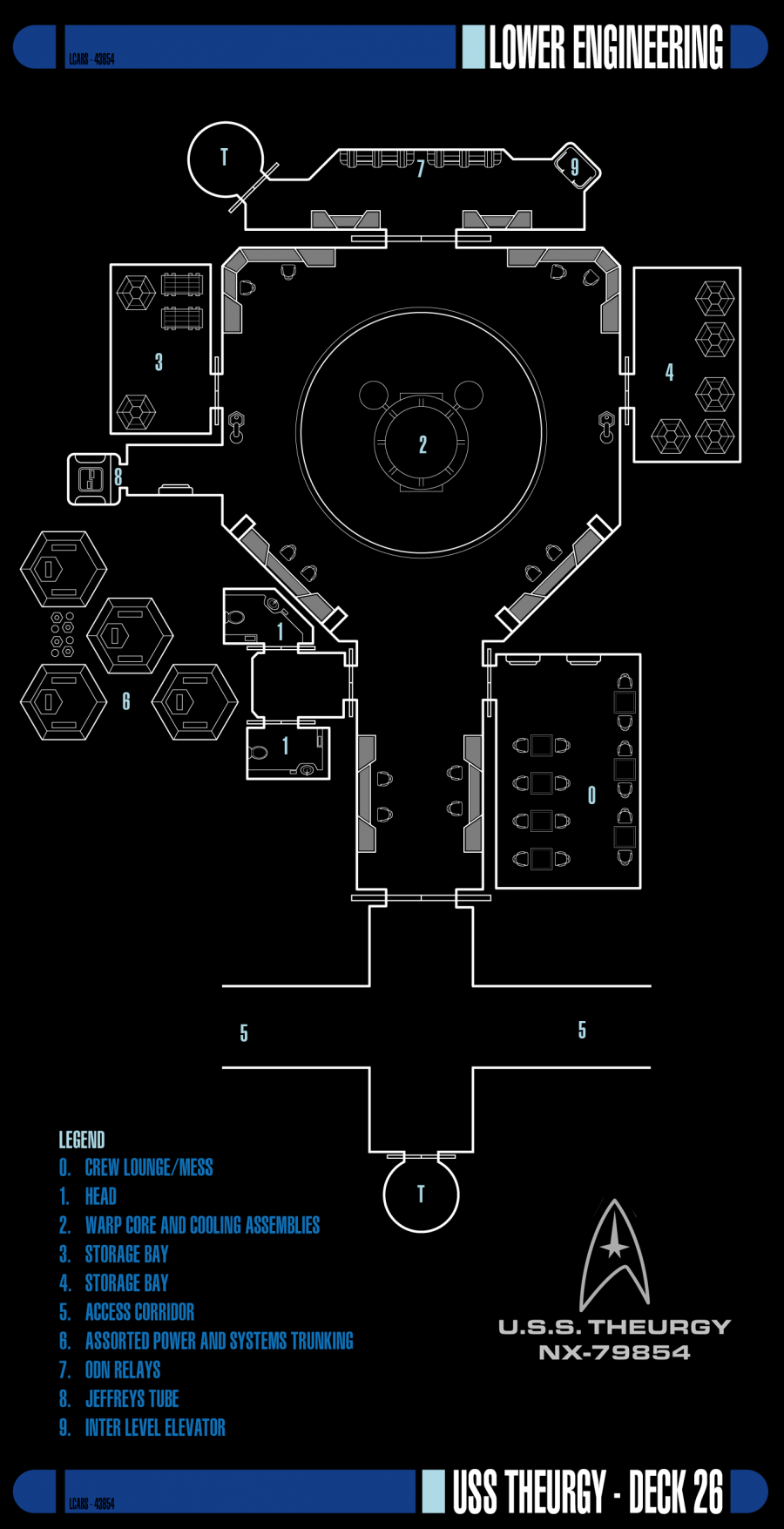
Full Resolution View at DeviantArt: http://auctor-lucan.deviantart.com/art/Lower-Engineering-Deck-26-USS-Theurgy-NX-79854-680616556
Auxiliary Engineering 01 & 02
The Theurgy had MVAM functionality, so this was one of the two auxiliary warp core areas, where the warp core was horizontal instead of vertical. The reaction chamber coukd be seen in the hole in the deck before the main console. Both auxiliary engineering areas were identical.
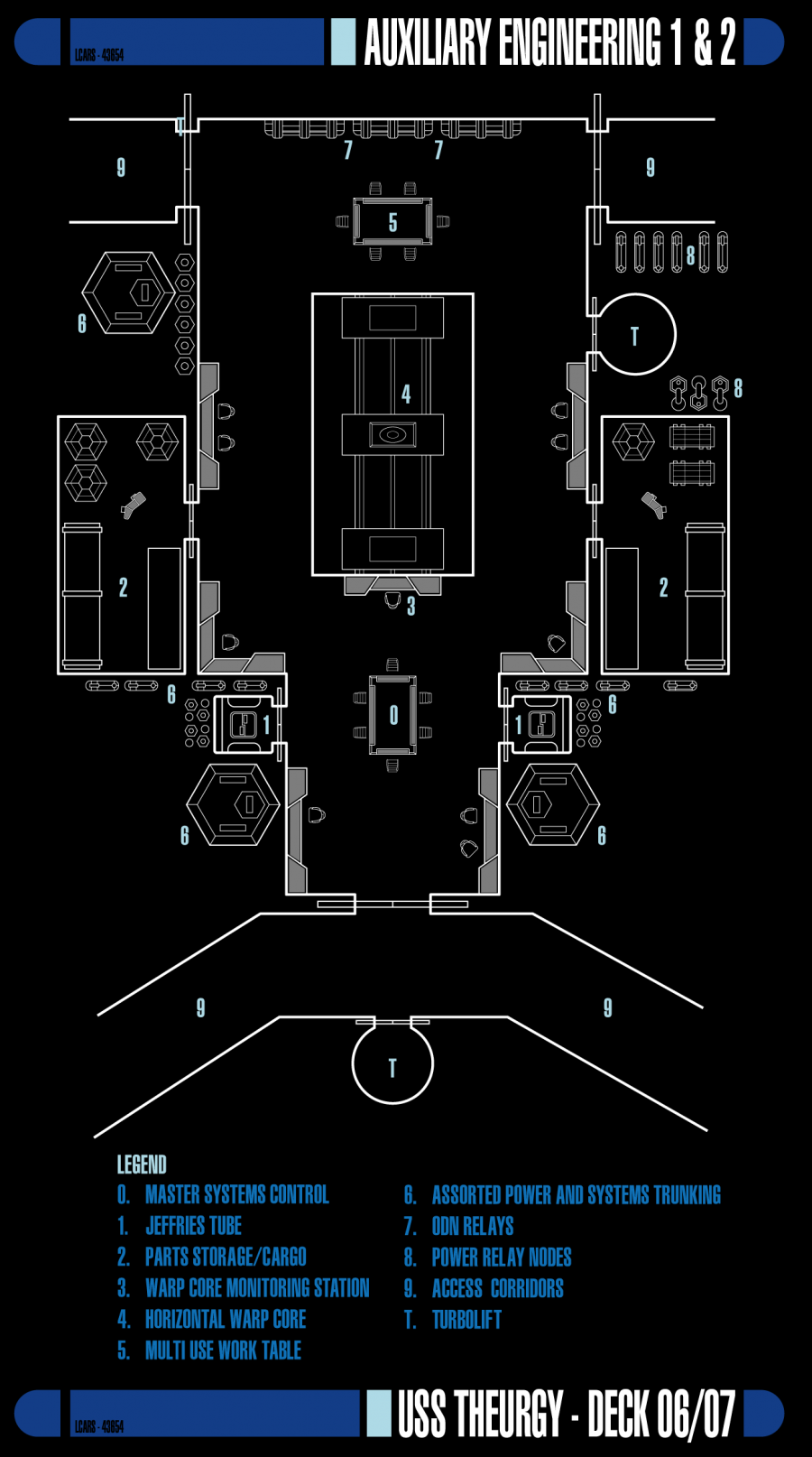
Full Resolution View at DeviantArt: http://auctor-lucan.deviantart.com/art/Auxiliary-Engineering-01-and-02-USS-Theurgy-680617026
Warp Core Ejection
In the event of a warp core breach, the Therugy-class starship could eject the warp core. This procedure required the authorization code of the chief engineer or a member of the senior staff. The core was ejected through the ejection port on the hull. Magnetic rails inside the channel accelerated the core once disengaged from the vessel and fired it away from the ship. Under normal circumstances, the vessel then moved away from the core as fast as possible under impulse power.
Should the core not go critical, the vessel could recover it with tractor beams and reintegrate it with careful manipulation.
Scientific Systems
A Theurgy-class starship housed over one hundred separate scientific research labs. Very few of the research labs remained under the same discipline of science for more than six months. Most shared the same design; only a few had extremely specialized equipment.
Stellar Cartography
While most laboratories were shared, Theurgy-class vessels had specific stellar cartography facilities on Deck 15. Based in a large cylindrical room, the walls of the room were designed to be a three-dimensional display and spans two decks.
Arboretum
The arboretum was a triple deck room capable of studying and supporting a wide variety of plant life, and also doubled as a social area.
Tactical Systems
Pulse Phaser Arrays
The Theurgy-class utilized a ship-mounted pulse phaser array system. The pulse phaser arrays were similar to the Phaser Cannon assemblies on Defiant-class starships, but were tuned to allow an great arc of fire like conventional phaser beam emitters.
Torpedo Launchers
Torpedo launcher or torpedo bank was a common term for systems that deployed projectiles such as torpedoes and probes. A torpedo tube was a part of a torpedo launcher. Torpedo launchers could usually be accessed by personnel from a torpedo bay. The Theurgy was equipped with forward and aft-facing torpedo launchers on all three Vectors.
Crew Support Systems
Medical Facilities
Sickbay
Sickbay is an old Navy term for «ship’s hospital», which continued even into the 24th Century. Here we will discuss the various parts of the USS Theurgy Sickbay.
Recovery Ward
Pretty much where you’d end up if your illness or injury was not too life-threatening but the doctor required you to hang around overnight for treatment and/or monitoring. Also, this was where non-critical patients were placed after surgery. It included 12 biobeds with overhead monitors, sanitized pillows and sheets for each bed, one replicator, and a supply storage cabinet close by.
Primary Care Unit [PCU]
This was where you’d be treated for bumps, bruises, common diseases, and anything else that didn’t look to be particularly life-threatening. Included 12 scanning biobeds.
Intensive Care Unit [ICU]
This was where you would go if the doctors weren’t sure whether you’d die soon or not and there was little more they can do about it but watch and wait. Each biobed was rigged for constant 3-dimensional scanning and monitoring of the patient. It included a computer link-up to an adjustable «Code Blue» alarm system that sounded the instant a patient’s life-signs fell out of the acceptable parameters. It also included one replicator, additional life support hardware for each bed, back-up battery power on a separate power grid from the ship, atmospheric isolation systems, and a supply storage closet nearby.
Medlabs
The primary laboratory for Sickbay’s use. Included one replicator, material diagnostics stations, a centrifuge, gene analysis terminal, a table for post-mortum examinations, and stasis field drawers for storage of biological samples, corpses, or patients requiring treatment not available on the ship. [Also Medlab 02]
Surgical Suites
If you needed surgery to save your life, correct an illness, fix a serious injury, or just have yourself cosmetically altered for an undercover assignment, this was where they’d have you laid out. Along with the usual surgical tools, the room included mobile life support equipment, a replicator, atmospheric isolation systems, and scanning/monitoring readout station.
Holographic Projection Grid
Two EMH programs were available, the longer term Mark II and the short term Mark I. Developed to act as the Chief Medical Officer as and when required, these programs could also be activated to provide additional assistance to the real Chief Medical Officer. The EMH were programmed with all current medical knowledge and had the ability to learn as required. Additionally, the EMH could take on any other medical role as required by the ship/facility.
Unlike previous EMH systems with primary emitters inset into the ceiling every 1.5 meters and larger back-up emitters inset into the center of each ceiling over the Recovery Ward, Primary Care Unit, Medlab-1, and both operating rooms being fully integrated with Sickbay’s computer hardware to prevent accidental loss of the EMH at critical moments, the Theurgy-class took the EMH one step further, having holo-emitters in every area of the ship, allowing the good doctors to venture outside of Sickbay to treat the wounded more efficiently, just like the Ship’s A.I. Hologram.
Battle Sickbays
Because of the Theurgy’s MVAM-mode, many main areas of the ship were duplicated, this included the Sickbay. Vector 01 and 03 sections both contained a full Sickbay. Vector 02’s Sickbay (the saucer section) was the Main Sickbay area [discussed above], while the other two Vectors had one Battle Sickbay each. These were much larger than the Main Sickbay, and with its open layout that gave the medical personnel more freedom of movement, it was designed specifically for battle conditions.
Morgue
A morgue facility with storage slots for several bodies was located adjacent to the sickbay.
Counselor’s offices
The Chief Counselor had their own office in Main Sickbay, on Deck 11. The majority of the crew members needing emotional support, however, could meet in private with the officers in the Theurgy´s Counseling Department on Deck 09. On Deck 09, there were several offices for the ship’s rehabilitation needs.
